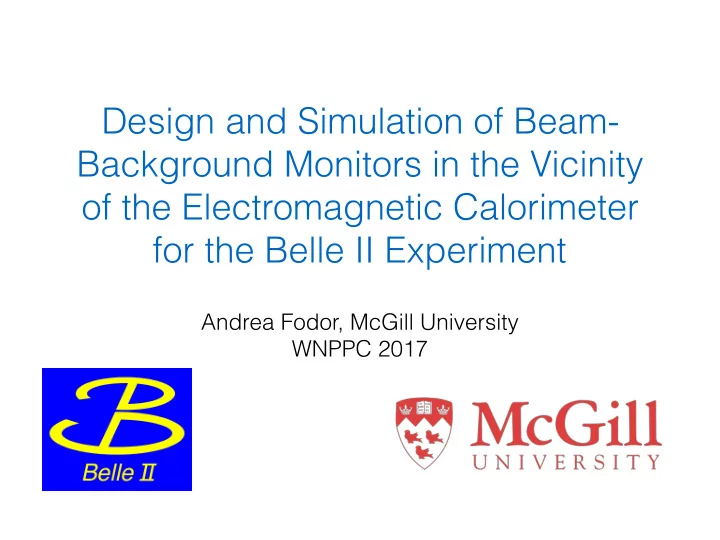

Design and Simulation of Beam- Background Monitors in the Vicinity of the Electromagnetic Calorimeter for the Belle II Experiment Andrea Fodor, McGill University WNPPC 2017
Belle II experiment and SuperKEKB • Electron - positron collider located at KEK Laboratory in Tsukuba, Japan • High Energy electron ring (HER) - 7 GeV • Low Energy positron ring (LER) - 4 GeV • Collisions at the center of mass energy 10.58 GeV ⇒ Y(4S) resonance • Successor to the KEKB collider • “Nano-beam” and continuous injection scheme • Design integrated luminosity 50 ab − 1 • Design instantaneous luminosity 8 · 10 35 cm − 2 s − 1 2 times larger ◆ ✓ R L ✓ I ± ξ y ± ◆ L = γ ± β ∗ 2 er e R ξ y y ± 20 times smaller 40-fold increase in instantaneous luminosity compared to KEKB WNPPC, February 2017 Andrea Fodor, McGill University 2
Belle II experiment and SuperKEKB • Belle experiment ran from 1999 to 2010 • Important discoveries including first observation of CP violation in the neutral B meson system Belle II Detector • All sub-detector components upgraded to match KL and muon detector: Resistive Plate Counter (barrel) the new record-breaking luminosity Scintillator + WLSF + MPPC (end-caps) EM Calorimeter: CsI(Tl), waveform sampling (barrel) Pure CsI + waveform sampling (end-caps) • Physics goals: • New Physics beyond Particle Identification Standard Model Time-of-Propagation counter (barrel) electron (7GeV) • Sensitivity to: Prox. focusing Aerogel RICH (fwd) • SUSY Beryllium beam pipe • charged Higgs 2cm diameter • dark photon Vertex Detector 2 layers DEPFET + 4 layers DSSD positron (4GeV) Central Drift Chamber He(50%):C 2 H 6 (50%), Small cells, long lever arm, fast electronics WNPPC, February 2017 Andrea Fodor, McGill University 3
Beam backgrounds at SuperKEKB • Deterioration of detector resolution, damage to detector components • Expected ~40-fold increase in beam backgrounds compared to KEKB • Scattered e - /e + hit the beam-pipe and create electromagnetic showers and neutrons • Simulations used to get an estimate of background rates in each sub-detector Beam-gas interactions Touschek scattering Luminosity backgrounds • e - e + Bhabha scattering • Coulomb scattering of beam • Intra-beam scattering • Followed by photon emission • Scattering rate inversely particles off of residual gas • Rate proportional to luminosity • Bremsstrahlung proportional to beam size, • Neutrons copiously produced in a • Proportional to beam current proportional to beam current photo-nuclear reaction of photons and iron H.Nakayama, KEK Synchrotron radiation Injection background • New particles injected every 100 ns • Collimators and shielding prevent • Newly injected particles interact scattered particles from reaching with existing beam particles the detector • Hard to simulate H.Nakayama, KEK WNPPC, February 2017 Andrea Fodor, McGill University 4
Beam-background monitors near ECL • Background monitors needed to ensure safe operation of electromagnetic calorimeter (ECL) • Live feedback to SuperKEKB control room about the background conditions in the detector • Belle used a scintillation detector attached to ECL backward shield • New ECL endcap shield design at Belle II • High density polyethylene (HDPE) + stainless steel layers neutrons γ /e ± showers • Proposal : make recesses in HDPE layer which would enclose the scintillation-detector based beam-background monitors • Needs : • Fast timing for observing the injection backgrounds • Wide energy range • High radiation hardness A. Beaulieu, UVic WNPPC, February 2017 Andrea Fodor, McGill University 5
Beam-background monitors: design Hamamatsu R7761-70 Photomultiplier LYSO crystal • wavelength of emission maximum at 420 nm • suitable for operation in high magnetic field • short decay time of 40 ns • peak wavelength 420 nm → well matches the beam top-up time of 100 ns • gain 10 4 at 1.5 T • compact design, 39 mm diameter • high light yield of 32000 photons/MeV • radiation length of 1.14 cm • good radiation hardness • radioactive isotope 176 Lu → 30 × 30 mm cylindrical crystals Hamamatsu Hamamatsu WNPPC, February 2017 Andrea Fodor, McGill University 6
ECL background simulation • Looking at the ECL background simulation to determine the hit distribution and average energy deposition and hit frequency • Interval of energy per hit on the order of 1 keV - 100 MeV TouschekLER - Deposited energy in backward endcap CoulombLER - Deposited energy in backward endcap GeV GeV y [cm] y [cm] 150 150 0.6 0.6 100 100 0.5 0.5 50 50 0.4 0.4 0 0 0.3 0.3 − − 50 50 0.2 0.2 − − 100 100 0.1 0.1 − − 150 150 0 0 − − − − − − 150 100 50 0 50 100 150 150 100 50 0 50 100 150 x [cm] x [cm] • 8 detectors in total • ϕ = {0, 90, 180, 270} degree in forward and backward shield WNPPC, February 2017 Andrea Fodor, McGill University 7
Beam-background monitors: simulation Edep [GeV] Background monitors included in the Belle II simulation BWD 6 FWD 2 cellID Edep [GeV] 7 3 1 5 4 8 y cellID x towards the outside of the ring center of the ring WNPPC, February 2017 Andrea Fodor, McGill University 8
Beam-background monitors: next steps • Read-out system being designed by Université de Montréal • Lab tests starting in couple of weeks • Installation in summer 2017 • Phase 2 data taking starting in February 2018 • Monitors stay active during phase 3 data taking, starting December 2018 WNPPC, February 2017 Andrea Fodor, McGill University 9
Recommend
More recommend